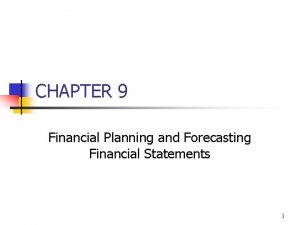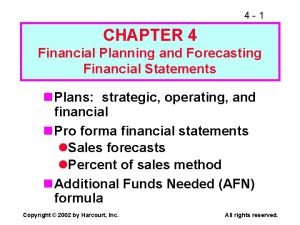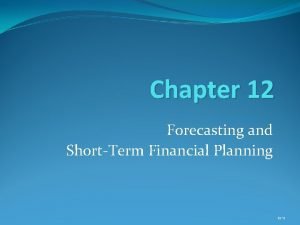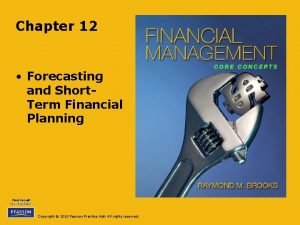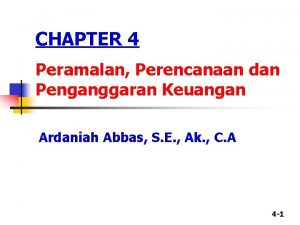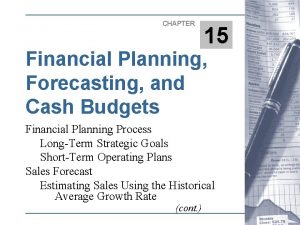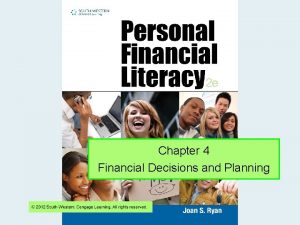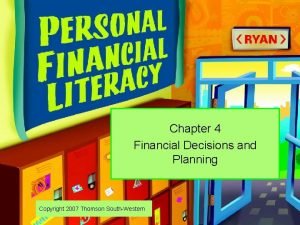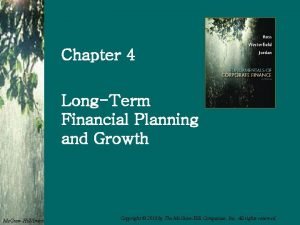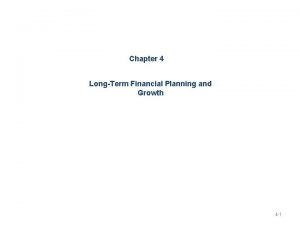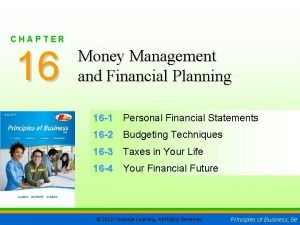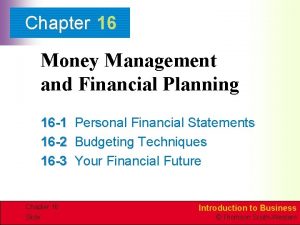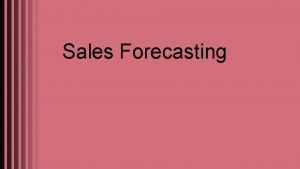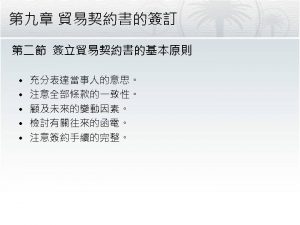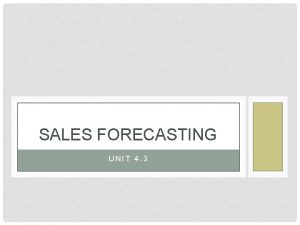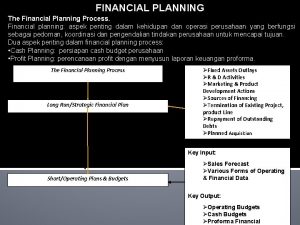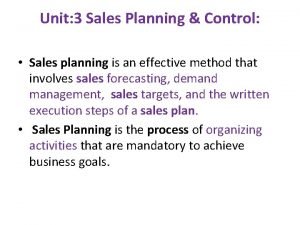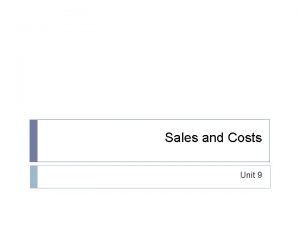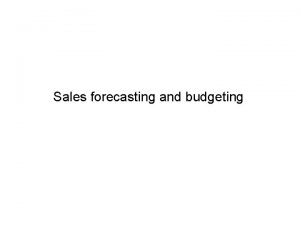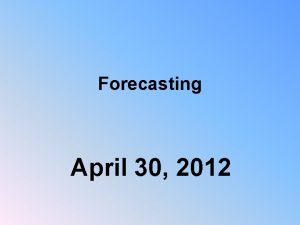Chapter 17 Financial Planning and Forecasting Forecasting Sales
















- Slides: 16

Chapter 17 Financial Planning and Forecasting § Forecasting Sales § Projecting the Assets and Internally § § Generated Funds Projecting Outside Funds Needed Deciding How to Raise Funds 17 -1

Preliminary Financial Forecast: Balance Sheets (Assets) Cash and equivalents Accounts receivable Inventories Total current assets Net fixed assets Total assets 2008 $ 20 240 $ 500 $1, 000 2009 E $ 25 300 $ 625 $1, 250 17 -2

Preliminary Financial Forecast: Balance Sheets (Liabilities and Equity) Accts payable & accrued liab. Notes payable Total current liabilities Long-term debt Common stock Retained earnings Total liabilities & equity 2008 2009 E $ 100 $ 125 100 190 200 315 100 190 500 200 245 $1, 000 $1, 250 17 -3

Preliminary Financial Forecast: Income Statements Sales Less: Variable costs Fixed costs EBIT Interest EBT Taxes (40%) Net income Dividends (30% of NI) Addition to retained earnings 2008 $2, 000. 0 1, 200. 0 700. 0 $ 100. 0 16. 0 $ 84. 0 33. 6 $ 50. 4 $15. 12 $35. 28 2009 E $2, 500. 0 1, 500. 0 875. 0 $ 125. 0 16. 0 $ 109. 0 43. 6 $ 65. 40 $19. 62 $45. 78 17 -4

Key Financial Ratios Basic earning power Profit margin 2008 10. 00% 2. 52% 2009 E 10. 00% 2. 62% Ind Avg 20. 00% 4. 00% Comment Poor Return on equity 7. 20% 8. 77% 15. 60% Poor Days sales outstanding Inventory turnover Fixed assets turnover Total assets turnover Debt/assets Times interest earned Current ratio Payout ratio 43. 8 days 32. 0 days 8. 33 x 11. 00 x 4. 00 x 5. 00 x 2. 50 x 30. 00% 40. 40% 36. 00% 6. 25 x 7. 81 x 9. 40 x 2. 50 x 1. 99 x 3. 00 x 30. 00% Poor OK Poor OK 17 -5

Key Assumptions in Preliminary Financial Forecast for NWC § § Operating at full capacity in 2008. § Payables and accruals grow proportionally with sales. § § Each type of asset grows proportionally with sales. 2008 profit margin (2. 52%) and payout (30%) will be maintained. Sales are expected to increase by $500 million. (% S = 25%) 17 -6

Determining Additional Funds Needed Using the AFN Equation AFN = (A 0*/S 0) S – (L 0*/S 0) S – M(S 1)(RR) = ($1, 000/$2, 000)($500) – ($100/$2, 000)($500) – 0. 0252($2, 500)(0. 7) = $180. 9 million 17 -7

Management’s Review of the Financial Forecast § Consultation with some key managers has yielded the following revisions: § Firm expects customers to pay quicker next year, § § thus reducing DSO to 34 days without affecting sales. A new facility will boost the firm’s net fixed assets to $700 million. New inventory system to increase the firm’s inventory turnover to 10 x, without affecting sales. 17 -8

Management’s Review of the Financial Forecast § These changes will lead to adjustments in the firm’s assets and will have no effect on the firm’s liabilities and equity section of the balance sheet or its income statement. 17 -9

Revised (Final) Financial Forecast: Balance Sheets (Assets) Cash and equivalents Accounts receivable Inventories Total current assets Net fixed assets Total assets 2008 $ 20 240 $ 500 $1, 000 2009 F $ 67 233 250 $ 550 700 $1, 250 17 -10

Key Financial Ratios – Final Forecast Basic earning power Profit margin 2008 10. 00% 2. 52% 2009 F 10. 00% 2. 62% Ind Avg 20. 00% 4. 00% Comment Poor Return on equity 7. 20% 8. 77% 15. 60% Poor Days sales outstanding Inventory turnover Fixed assets turnover Total assets turnover Debt/assets Times interest earned Current ratio Payout ratio 43. 8 days 34. 0 days 32. 0 days 8. 33 x 10. 00 x 11. 00 x 4. 00 x 3. 57 x 5. 00 x 2. 50 x 30. 00% 40. 40% 36. 00% 6. 25 x 7. 81 x 9. 40 x 2. 50 x 1. 98 x 3. 00 x 30. 00% OK OK Poor OK 17 -11

What was the net investment in capital? 17 -12

How much free cash flow is expected to be generated in 2009? FCF = = EBIT(1 – T) – Net investment in capital $125(0. 6) – $225 $75 – $225 -$150 17 -13

Suppose Fixed Assets Had Been Operating at Only 85% of Capacity in 2008 § The maximum amount of sales that can be supported by the 2008 level of assets is: § 2009 forecast sales exceed the capacity sales, so new fixed assets are required to support 2009 sales. 17 -14

How can excess capacity affect the forecasted ratios? § § Sales wouldn’t change but assets would be lower, so turnovers would improve. Less new debt, hence lower interest and higher profits § EPS, ROE, debt ratio, and TIE would improve. 17 -15

How would the following items affect the AFN? § Higher dividend payout ratio? § Higher profit margin? § Increase AFN: Less retained earnings. § Decrease AFN: Higher profits, more retained earnings. § Higher capital intensity ratio? § Pay suppliers in 60 days, rather than 30 days? § Increase AFN: Need more assets for given sales. § Decrease AFN: Trade creditors supply more capital (i. e. , L 0*/S 0 increases). 17 -16
 Financial planning and forecasting
Financial planning and forecasting Financial planning and forecasting
Financial planning and forecasting Short term financial planning process
Short term financial planning process Financial planning and forecasting problems with solutions
Financial planning and forecasting problems with solutions Financial analysis planning and forecasting
Financial analysis planning and forecasting Financial planning budgeting and forecasting
Financial planning budgeting and forecasting Research paper on financial planning and forecasting
Research paper on financial planning and forecasting Chapter 15 financial forecasting for strategic growth
Chapter 15 financial forecasting for strategic growth Chapter 4 financial decisions and planning
Chapter 4 financial decisions and planning Chapter 4 financial decisions and planning
Chapter 4 financial decisions and planning Long term financial planning and growth chapter 4
Long term financial planning and growth chapter 4 Long-term financial planning and growth
Long-term financial planning and growth Chapter 16 money management and financial planning
Chapter 16 money management and financial planning Chapter 16 money management and financial planning
Chapter 16 money management and financial planning Chapter 4 financial decisions and planning
Chapter 4 financial decisions and planning Chapter 4 financial decisions and planning
Chapter 4 financial decisions and planning Chapter 4 financial decisions and planning
Chapter 4 financial decisions and planning
